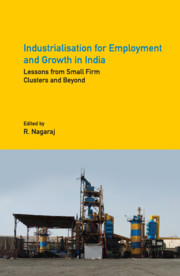Book contents
- Frontmatter
- Contents
- List of Tables
- List of Figures and Maps
- Preface and Acknowledgements
- 1 Introduction
- 2 Garment Cluster in Kolkata: The Untold Story of Expansion Relying on Low-end Domestic Demand
- 3 Constraints to Upgrading and Employment Expansion in the Tiruppur Knitwear Cluster
- 4 Determinants of Employment in the Indian Automobile Industry
- 5 Upgrading Technology and Space as Collective Strategy: Creation of Jobs and Market Potential in Gujarat’s Ceramic Clusters
- 6 Sports Equipment Manufacturing in India: A Firm-level Inquiry into Growth and Employment Dynamism
- 7 Aligarh Lock Cluster: Unravelling the Major Impediments
- 8 Continued Misery or a Change in Fortune? The Case of the Howrah Foundry Industry
- 9 Redevelop and Perish, or Survive and Grow? The Case for Supporting Informal Leather Enterprises in Dharavi, Mumbai
- 10 Growth Performance, Competitiveness and Employment in MSMEs: A Case Study of the Rajkot Engineering Cluster
- 11 Manufacturing and Automation
- About the Contributors
- Index
8 - Continued Misery or a Change in Fortune? The Case of the Howrah Foundry Industry
Published online by Cambridge University Press: 31 July 2021
- Frontmatter
- Contents
- List of Tables
- List of Figures and Maps
- Preface and Acknowledgements
- 1 Introduction
- 2 Garment Cluster in Kolkata: The Untold Story of Expansion Relying on Low-end Domestic Demand
- 3 Constraints to Upgrading and Employment Expansion in the Tiruppur Knitwear Cluster
- 4 Determinants of Employment in the Indian Automobile Industry
- 5 Upgrading Technology and Space as Collective Strategy: Creation of Jobs and Market Potential in Gujarat’s Ceramic Clusters
- 6 Sports Equipment Manufacturing in India: A Firm-level Inquiry into Growth and Employment Dynamism
- 7 Aligarh Lock Cluster: Unravelling the Major Impediments
- 8 Continued Misery or a Change in Fortune? The Case of the Howrah Foundry Industry
- 9 Redevelop and Perish, or Survive and Grow? The Case for Supporting Informal Leather Enterprises in Dharavi, Mumbai
- 10 Growth Performance, Competitiveness and Employment in MSMEs: A Case Study of the Rajkot Engineering Cluster
- 11 Manufacturing and Automation
- About the Contributors
- Index
Summary
Introduction
The contemporary literature on industrial development and the manufacturing sector in India acknowledges that both manufacturing sector output and employment have witnessed stagnation in the recent past. We make this observation mainly in terms of manufacturing employment with the backdrop that manufacturing output has also not increased significantly during the period under study (Table 8A.1). At the all-India level, we find that the percentage of manufacturing workers in total employment declined from 11.6 per cent in 2001 to 10.1 per cent in 2011. In 1991, this share was 9.5 per cent; so over two decades, there was hardly any change in the share of manufacturing in total employment (Table 8A.2).
At the state level, most of the major states showed a decline in the share of manufacturing in total employment. For some of the major states, the share even went below the level in 1991. For West Bengal, the share of manufacturing workers as a percentage of total workers declined from 18 per cent in 2001 to 15.3 per cent in 2011, marginally below the 1991 level of 15.9 per cent (Table 8A.2). Alongside employment, West Bengal's ranking in terms of real per capita total manufacturing net state domestic product (NSDP) also consistently declined between 1990–91 and 2011–12 (Nagaraj 2016). In 1990–91, West Bengal ranked sixth amongst the 17 major states considered, and in 2011–12, it ranked 12th in terms of real per capita total manufacturing NSDP. The state ranked fourth in the year 1970–71. Therefore, there is enough evidence of industrial stagnation for the state of West Bengal in terms of both manufacturing employment and output.
In this chapter, we try to study an industrial cluster in the state and illustrate the macro stagnation by searching for similar evidence at the micro level and analyse a few reasons behind the stagnation of the chosen industrial cluster. We choose West Bengal as it was one of the leading states in the manufacturing sector but has over time failed to sustain its position. Within West Bengal, we choose Howrah district. With nearly 40 per cent of its workers in manufacturing, Howrah has remained one of the top industrialised districts in the state and in the country for more than two decades.
- Type
- Chapter
- Information
- Industrialisation for Employment and Growth in IndiaLessons from Small Firm Clusters and Beyond, pp. 173 - 195Publisher: Cambridge University PressPrint publication year: 2021



